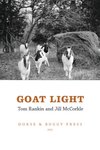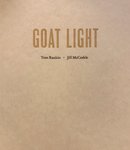

Duke University professor, photographer, folklorist and author Tom Rankin and his wife, novelist and award-winning short-story writer Jill McCorkle, will be featured in Chatham Literacy’s “Virtual Spring Author Event” on April 20.
This online event includes live discussions with the couple about their acclaimed book, “Goat Light,” which showcases vivid photography and reflective stories about their rural Piedmont lifestyle.
News + Record Publisher Bill Horner III interviewed the couple for a video posted on the Facebook pages of the newspaper and Chatham Literacy; that video can be found at https://www.youtube.com/watch?v=oQmsvKrQbnw. A shortened version of the interview, which has been edited for clarity and brevity, appears below.
Registration for the fundraiser is $100 and includes one door prize raffle ticket. The virtual event will be held on the Zoom videoconferencing platform from 11 a.m. – 12:15 p.m. Register at www.chathamliteracy.org or by calling 919-742-0578.
Goat Light, published by Horse & Buggy Press in Durham, is a folded-gathered-and-bound limited edition book. For more information, go to https://www.horseandbuggypress.com/goat-light.
Tom Rankin currently directs the MFA in Experimental and Documentary Art and is Professor of the Practice of Art at Duke University. His writing has been published widely in magazines, journals and books, among them: Sacred Space: Photographs from the Mississippi Delta and Local Heroes Changing America: Indivisible. His award-winning photographs are in many private and museum collections — and appeared in such stellar exhibits as the Nasher’s “Southern Accent: Seeking the South in Contemporary Art.”
Jill McCorkle has published four short story collections and novels, all as critically acclaimed as “vibrant and engaging” — including the 2020 released Hieroglyphics. A New York Times reviewer, in writing about Hieroglyphics, said: “A good novel can perform the same perception-bending trick as a lockdown: slowing time, throwing light on shadowed corners, reminding us of the interdependencies among us that we once took for granted.”
The couple lives in Orange County.
You’re both creators. What drives you in the writing and other creative work that you do?
JILL: I think the creative process is just so much a part of every ordinary day, both as a reader and as a writer, as someone observing, taking notes. And so even if I don’t have time to sit down and formally write for x-number of hours, that creative process really is what guides each and every day, and the notes that mark and distinguish that day from another.
TOM: I think I’ve always been fascinated by the creative process. I’ve been fascinated by the fact that it’s universal. When I was a kid, I’d go in somebody’s backyard, and some old man would be putting a new hoe handle on his hoe, and I would watch him, and watch him create this piece that would fit in this hoe, and attach it. And I feel like that I’m still doing the same thing. I’m wandering around the world looking for things that really engage me and really kind of enliven the day. And it’s about listening. I mean, photography is about listening and looking. And yet, I also want to make work that will last — like the guy who makes the hoe handle, you know … he wants it to last. That’s really what it’s about for me.
Let’s talk about “Goat Light.” This is such a unique project. And it’s really interesting to me that this is your first project that you’ve collaborated on together. Is that correct?
TOM: Other than just living together? (Laughs.)
JILL: Well, I’m the sidekick on this one, because really, the focus of the book is so much on Tom’s photography, and the documentation of the daily life of tending goats and animals, and various animals coming and going in life. And so much of what I have written for the book is just in conversation with the photographs that he’s taken.
TOM: We enjoy a lot of the same things. And Jill likes nothing better than animals. We’ve always had altogether way too many animals. You know, if two is good then three must be better, and so on and so forth. And so I think some of the collaboration just grows naturally out of out of that.
And then I did find that so much really interesting, compelling art comes from close to home. And so I started very consciously thinking, Well, how beautiful is it at 6:30 in the morning when I’m feeding goats? I should start photographing them. Why not? And one thing led to another … and words and pictures have a long history together. And so it seemed sort of a natural, organic evolution to think, well, maybe we should do a book.
So why goats? Because you’re not farmers, right? You’re creative people and educators…
TOM: With me living out on land, I wanted animals, and I wanted fairly self-sufficient animals because, as you say, we’ve got regular jobs. And goats … the joke is goats are the last of the self-sufficient breed in a way, and yet they’re always getting out and they have challenges. So that’s really ‘why goats.’ Cows are too big for one person. I didn’t want anything that would require me hiring some help. You can pick up a goat by yourself.
So then, I think, and this is in all seriousness … there’s a way in which goats teach you what you can and can’t control. It became and it is a kind of really nice balance to me, the way most of us live day to day. It became almost like a therapeutic occupation on the side.
I joke that, you know, you go to a faculty meeting at any university, and nothing ever is resolved. You go out and check on your goats, and it’s resolved. In all seriousness, I think that’s really what the goats have given me. I don’t know what I’ve given them, but that’s what they’ve given me. And then I love to watch them …
JILL: I’m more a dog person. But you know, I love the goats. And there’s nothing cuter than a pasture full of kids.
“Goat Light” is a unique book in many respects, but also physically unique. Why did you choose this specific type of physicality for the book?
TOM: I really like photographs as objects. I like books as objects. Here we are in a digital age, and there’s great advantages to that, but I really do like the material of the photograph. And so the idea of making a book that we don’t have to lose money on, but that’s what we really want … so that’s how it came about. It has a letterpress cover ,so the cover is handmade and has a lot of handwork involved in it. … The intent was never to make a kind of coffee table, “home on the farm” book, but more of an artist’s book.
Jill, for you, as a novelist, and someone who’s had more traditional books published, was the writing experience for this book different than other types of writing you’ve done?
JILL: I focused on the personalities of various dogs and goats. And that was my way. I think my work as a fiction writer is a lot about projection, and exaggeration at times, and so it seemed an easy step to project a lot of emotion into the lives of the goats, whether it’s really there or not. I think that’s what I was always observing and seeing.
TOM: One of the things you learn, and Jill writes about, it is the mortality, the reality of mortality, that we’re always facing. Animals have a relatively short life expectancy. If it can go wrong, if you farm, it will. And so Jill does write about that reality, about the loss, the wonder of having things and then the loss of those things. And, you know, we all know that, but we often don’t get to, we don’t reflect on it enough, maybe?
I’d like to hear from you about the role that literacy plays in your lives and why you think it’s important, because without literacy, there wouldn’t be consumers of the work that you do or we do. So share some thoughts about that as we wrap up...
JILL: I think that what literacy brings to an individual’s life is, in itself, another life. And it’s that other place I’m always so thrilled to go at the end of the day. Because I think we replenish ourselves, and our minds and imagination, through reading, and whatever we’re reading, it’s a little mini vacation. This year, more than ever, I see those books as tickets — tickets!
And why should people attend this event, on April 20? What will they get from you?
TOM: Well, I think we’ll try to be as entertaining as possible. If you’ll come on April 20, we’ll show some images and we’ll talk about what we do. But the bigger reason to come is obviously to support Chatham Literacy and to support the whole idea of literacy — not only for yourself, but for all the people who may not be there on April 20. And to support where we are — our book is about the uber-local, about the back yard. There’s nothing more essential than to support the “local,” whatever that word means to you.